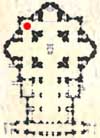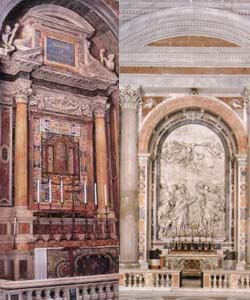| Grottoes
Vatican City Colonnade Saints Floorplan #2 |
| Altars
Monuments The History |
| Related
Items St Leo the Great |
From: 'St. Peter's - Guide to Basilica and Square'
We now enter the Chapel of Our Lady of the Column, surmounted by one of
the smaller cupolas, a corner chapel, located at the end of the left aisle.
On the right of the chapel is the Altar of St. Leo the Great (440-461), the first pope to be buried in the basilica. When he died, he was buried in the sacristy of the ancient basilica, and his body was subsequently moved to the Porticus Pontificum. Finally, Paul V desired it to be translated to this chapel, together with the remains of Popes Leo II, Leo III, Leo IV and Gregory XIII. The great carved marble altarpiece by Alessandro Algardi (1602-1625) portrays the Meeting of Pope Leo the Great with Attila, King of the Huns, whose advance on Rome in 452 the Pope had succeeded in halting, thereby saving Rome from destruction.
On the left is the Altar of Our Lady of the Column called after the image of the Blessed Virgin painted on a column from the old basilica. In 1607 it was placed on this altar designed by Giacomo Della Porta, framed by the finest marbles and precious alabaster columns. After the Second Vatican Council, Paul VI honored it with the title of "Mater Ecclesiae". In 1981 John Paul II had a mosaic reproduction of it set on the external wall of the palazzo facing St. Peter's Square, where it can also be seen illuminated at night.
The chapel is covered by one of the basilica's minor cupolas which lets in light that enhances the colors of the altar. On the vault of the dome are portraits of the Litany of Loreto; in the spandrels: St. Bonadventure, St. Thomas Aquinas, St. Cyril of Alexandra, St. John Damascene. In the lunettes are portrayed: The Virgin Mother and Child, the Dream of St. Joseph, and the Kings, David and Solomon.
From:
'St. Peter's Basilica - A Virtual Tour' by Our
Sunday Visitor
Continuing on, we enter the Virgin of the Column Chapel, so called because
of the Virgin's image designed on a piece of column of porta santa marble,
which was part of the central nave of the Old Basilica. It was transferred
here in 1607 and crowned by the Chapter in 1645.
Beneath the altar lie the remains of the Sts. Leo II, III and IV, while at the center of the Chapel beneath the floor lies Leo XII, remembered by a humble epitaph which he himself dictated. It is also known as the St. Leo Chapel because of this. The cupola is decorated with symbolic figures taken from the Liturgy of Loreto, which are rather monotonous and were executed in 1757 based on cartoons by Giuseppe Zoboli.
The decoration of the corbels dates from much earlier (circa 1630) with two Doctors of the Greek Church, St. Germano and St. John Damascene, both the work of Sacchi, chosen among those who had particularly exalted the glory of Mary. The mosaicist was the famous Calandra in 1647 transformed the cartoons by F. Romanelli into mosaic in the lunettes. These show "David" and "Solomon," the '"Announcement of Mary's conception to Joseph" and "Mary with her sleeping Holy Son."
From:
'THE NEW SAINT PETER'S'
The ornamentation of the chapel is by Giacomo della Porta. The figures
of Saint Thomas and Saint John Damascene in the pendentives of the small
cupola are by Sacchi; Saints Januarius and Bonaventure by Lanfranco, transformed
into mosaic by Calandra. These are the Doctors who wrote most about the
Blessed Virgin.


